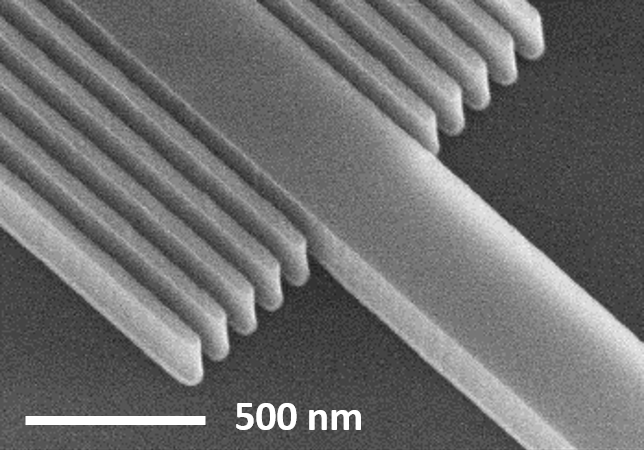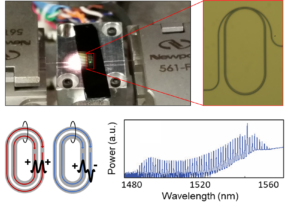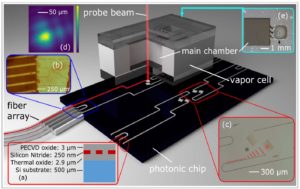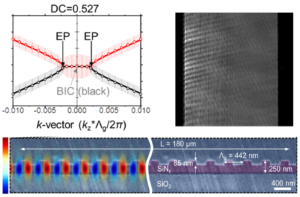Research
We explore both fundamental and technical aspects of photonics, aiming to bridge the gap between fundamental science and future technology. Our research primarily focuses on integrated nanophotonics, which develops chip-scale photonics integrated circuits (PICs), miniaturizing complicated and bulky table-top optical systems tiny and portable for various field applications. The followings are research topics that we have recently worked on. Each area is strongly correlated, and we always look forward to extending our expertise into other areas to impact the world.
On-Chip Integrated Metaphotonics with Subwavelength Gratings
 Analogous to electronics, increasing the photonic integration density and scaling up the PIC components is highly desired. Dense photonic circuits provide more building blocks for more functionalities, enhance modular power efficiency, and lower unit cost. However, unlike electronics, increasing the photonic chip density is extremely challenging, mainly due to the optical crosstalk caused by the evanescent fields in the waveguide cladding.
Analogous to electronics, increasing the photonic integration density and scaling up the PIC components is highly desired. Dense photonic circuits provide more building blocks for more functionalities, enhance modular power efficiency, and lower unit cost. However, unlike electronics, increasing the photonic chip density is extremely challenging, mainly due to the optical crosstalk caused by the evanescent fields in the waveguide cladding.
Our group has been working on this issue, especially utilizing the anisotropic subwavelength grating (SWG) metamaterials. Since SWGs form highly anisotropic and all-dielectric (thus, low-loss) metamaterials, they allow us to engineer the anisotropic properties to reduce the crosstalk between the adjacent devices while having negligible additional loss. We found two unique physical properties with SWGs (i.e., skin-depth engineering and anisotropic perturbation) and utilized them for miniaturizing PICs. We demonstrated record-high coupling length, achieving ≈500 times longer coupling length than a conventional strip waveguide. Our ultimate goal is to transform a traditional PIC into the next generation SWG-PIC, scaling up the overall PIC that is crucial for programmable (AI) PICs and quantum PICs.
[1] S. Jahani†, S. Kim†, et al. "Photonic Skin-Depth Engineering on a Silicon Chip using All-Dielectric Metamaterials," Nature Communications, 9, 1893 (2018) (†equal contribution)
[2] M. Mia, S. Ahmed, I. Ahmed, Y. Lee, M. Qi, and S. Kim, “Exceptional coupling in photonic anisotropic metamaterials for extremely low waveguide crosstalk,” Optica 7, 881-887 (2020)
[3] S. Ahmed, I. Ahmed, M. Mia, N. Jaidye, and S. Kim, "Ultra-high extinction ratio polarization beam splitter with extreme skin-depth waveguide," Optics Letters, 46(9), 2164-2167 (2021)
[4] M. Mia, S. Ahmed, N. Jaidye, I. Ahmed, and S. Kim, "Mode-evolution-based ultra-broadband polarization beam splitter using adiabatically tapered extreme skin-depth waveguide," Optics Letters, 46(18), 4490-4493 (2021)
[5] M. Kabir, M. Mia, I. Ahmed, N. Jaidye, S. Ahmed, and S. Kim, "Anisotropic leaky-like perturbation with subwavelength gratings enables zero crosstalk," Light: Science & Applications, 12, 135 (2023)
On-Chip Microcombs and Nonlinear/Quantum Photonics

Recent advances in high-Q microresonators can boost many nonlinear/quantum processes (that are typically weak in a free-space environment), allowing us to access a new regime of nonlinear/quantum science. Most representatively, optical frequency combs, which provide a very accurate grid in frequency and time domains, have been realized with a chip-scale photonic microresonator (thus, called microcomb). The compact and portable chip size allows microcomb technologies out of the laboratory and promises practical field applications like high-precision spectroscopy, frequency-time metrology, and optical communications.
Our group is developing novel microresonators and other components for advancing chip-scale nonlinear/quantum processes like microcombs. We are especially interested in engineering dispersions, which are crucial for the microcomb process. We have developed a concentric-microresonator to control the resonator dispersions, applicable to other material platforms and spectral regimes. Utilizing this approach, we aim to develop efficient microcombs at visible or mid-infrared ranges where various sensing and imaging applications exist. Furthermore, microcombs also exhibit entangled multiphoton pairs for quantum processing, where our research interest overlaps with quantum PICs.
[1] S. Kim, et al, "Dispersion Engineering and Frequency Comb Generation in Thin Silicon Nitride Concentric Microresonators," Nature Communications, 8, 372 (2017)
[2] G. Moille, Q. Li, S. Kim, D.A. Westly, and K. Srinivasan, "Phased-Locked Two-Color Single Soliton Microcombs in Dispersion-Engineered Si3N4," Optics Letters, 43, 2772-2775 (2018)
[3] Y. Xuan, … S. Kim, et al, "High-Q Silicon Nitride Micro-Resonators Exhibiting Low Power Frequency Comb Initiation," Optica, 3, 1171-1180 (2016)
[4] S. Fatema, M. Mia, and S. Kim, “Multiple mode couplings in a waveguide array for broadband near-zero dispersion and supercontinuum generation,” Journal of Lightwave Technology 39, 216-222 (2021)
Hybrid Integration of Photonic Chips with Atomic and Microfluidic Systems

Integrating photonic chips with other electronic, atomic, microfluidic, and quantum systems could expand the capabilities of photonic applications, and many recent research activities in photonics follow this trend. The NIST-on-a-Chip project may be the most representative example of such a trend, where NIST wants to integrate diverse measuring systems into a single chip. Realizing the full potential of such hybrid systems requires developing advanced mode converters interfacing different scales of beams/modes in each system. The manufacturing process also should be compatible with each system, requiring innovative chip architecture designs as a whole hybrid system.
Our goal in this topic is to develop a stable and universal hybrid system that can fully utilize the capabilities of photonic chips together with an atomic or microfluidic system. Extreme mode converters and in-plane metalens systems will be developed and utilized as key components for interfacing two different systems with a large mode mismatch. We expect such a hybrid system will find groundbreaking on-chip applications that were not precedented before.
[1] S. Kim, et al., “Photonic waveguide to free-space Gaussian beam extreme mode converter,” Light: Science & Applications 7, 72 (2018)
[2] M.T. Hummon, … S. Kim, et al., “Photonic chip for laser stabilization to an atomic vapor at a precision of 10-11,” Optica 5, 443-449 (2018)
On-Chip Exceptional Points & Other Research Topics

Recently, exceptional point (EP) singularities in non-Hermitian systems attracted researchers in various physical domains due to their non-conventional behaviors with degenerated eigenvalues and eigenvectors. In photonics, until recently, EPs were mostly explored with gain and loss to break time-reversal symmetry but caused difficulty in experiments. Our group found EPs in a passive waveguide with uniform gratings, which cause a non-Hermitian system with a radiative loss. We uncovered that these EPs can manifest exponential-decay free wave penetration with unusual, linearly varying wave amplitudes and spatially uniform energy losses over long penetration distances. Following up, we are developing such EPs in strip waveguides and ring resonators, which provide a more viable platform/scheme for nonlinear processes with EPs.
We also actively explore other exciting research directions, such as active & nonlinear photonics with the bound state in the continuum, surface phonon waves for mid-infrared sensors, and integrated pulse shapers for quantum processing. All the topics are highly correlated and utilize integrated nanophotonic chips.
[1] A. Yulaev*, S. Kim*, Q. Li, D.A. Westly, B.J. Roxworthy, K. Srinivasan, and V. Aksyuk, "Exceptional points in lossy media lead to deep polynomial wave penetration with spatially uniform power loss," Nature Nanotechnology 17, 583–589 (2022) (*equal contribution)
